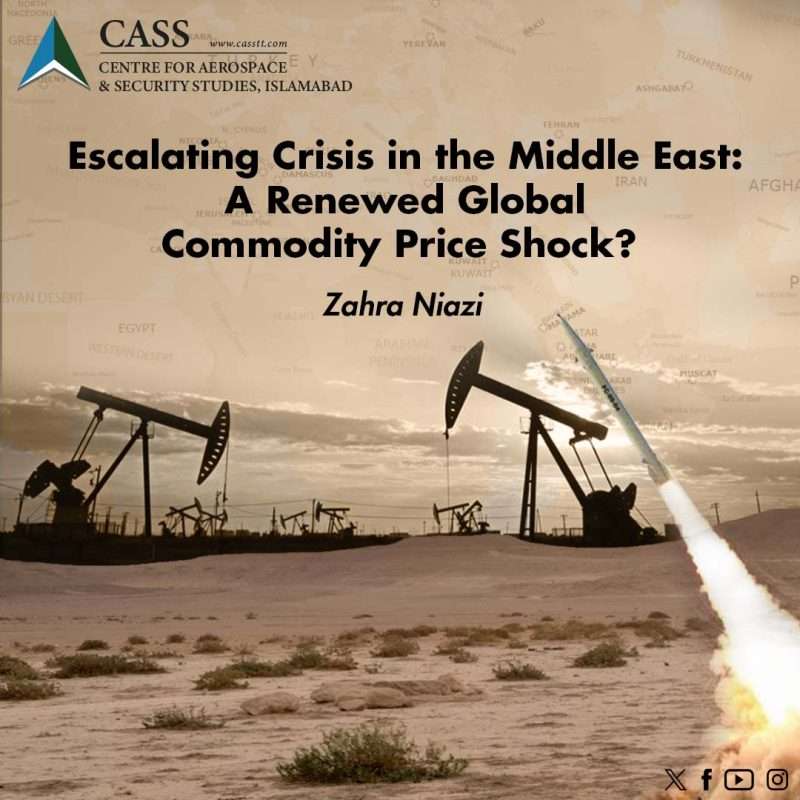The past few months were relatively calm for global commodity markets, allowing central banks to lower inflation targets and pivot to looser monetary policies. However, what many may not have factored into their calculations is this new nightmare on the cards – a resurgent volatility within commodity markets as the Middle Eastern region braces for a potential Israeli response to Iran’s missile attack on 1st October amid the expansion of Israel’s brutal aggression and assassination of key leaders.
The spillover impact of the escalating crisis is already visible within the crude market. From USD 71.77 per barrel on September 30th, the price of Brent Crude oil jumped to USD 77.72/bbl on 6th October, with the major impact coming from President Joe Biden’s comment on discussions with Israel of the possibility of strikes on Iran’s oil infrastructure. Although later contradicted by one of his subsequent statements, the option remains on the table, with analyses estimating that a major strike on Iran’s export capacity could take up to 1.5 million barrels per day (MMbpd) of supply off the market. Satellite imagery has revealed that oil tankers are already vacating waters around Iran’s principal Kharg terminal for crude exports, which had risen to 1.65-1.7 MMbpd in July-August despite US sanctions.
However, at least in the short term, several factors can still help moderate the impact of a major strike on Iran’s export capacity, should it occur. Notably, US crude inventories rose by 3.9 million barrels (MMbbl) to 417 MMbbl in the week ended September 27th, while OPEC+ has over 5 MMbpd of spare capacity, which could be tapped if needed. Assuming that OPEC+ refrains from increasing production, oil prices could soar by up to USD 20/bbl, as warned by Goldman Sachs, but there are well-founded reasons to argue that both Washington and OPEC+ would prefer to intervene, even if not immediately.
OPEC+ may not be comfortable with prices high enough to force a reduction in global oil demand or hasten transition towards a renewable energy future. Likewise, although the US is a significant oil producer, it still depends on imported oil and refined products due to the majority of its refining capacity being geared towards dealing with heavier and less sweet oil, unlike the one majorly produced at home. Additionally, gasoline prices in the US tend to move with Brent rather than West Texas Intermediate (WTI), which represents oil produced in the US. This also suggests why Washington would want to carefully weigh potential consequences of strikes on Iranian oil facilities – that too just weeks before the Presidential Elections.
Another front is the Red Sea, where Houthis have attacked and damaged an oil tanker and a bulk carrier in their new wave of attacks. They have reportedly also sent email alerts to several shipping companies to prepare for an attack on this trading route. Past months have, however, demonstrated that the Red Sea shipping crisis has not had large effects on global commodity markets, given the options for rerouting vessels.
It is the Strait of Hormuz where a significant disruption in trade flows could be the most problematic. The Strait serves as the only passage from oil-rich Gulf to the Indian Ocean responsible for handling about 30% of the world’s seaborne oil trade. In the worst case, prices can surge over USD 150/bbl if Iran shuts the Strait entirely – an option that could be easier for Tehran to pursue if it sees its oil production and export capacity targeted. While transmission pipelines exist as alternative outlets to the Strait, their limited capacities suggest they can only serve as imperfect substitutes.
Disruption in supplies through the Strait, accounting for 20% of the global LNG transit, can also drive up natural gas prices. Additionally, Tehran has warned of potential strikes on Israel’s energy and gas installations if provoked, which could add to price pressures, as Israel remains a significant gas producer and regional exporter.
Given the importance of energy in producing and transporting other commodities, aggregate commodity prices could surge. Such unrest within commodity markets would send shockwaves worldwide, although with varying degrees of impact across countries. The greatest effect will be felt in net-oil-importing countries, including most economies in Asia-Pacific and South Asia, such as Pakistan.
Looking ahead, the potential of a commodity price shock, should the conflict escalate, cannot be underestimated. Now is the time for the West to embrace strategic foresight and realise the extent of the potential ramifications of continuing to support Israel’s incessant aggression that has provoked regional players and spiralled the region into a crisis.
Zahra Niazi is a Research Assistant at the Centre for Aerospace & Security Studies (CASS), Islamabad, Pakistan. She can be reached at: [email protected].





